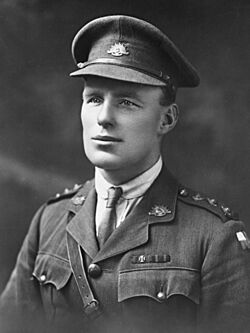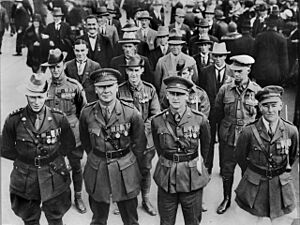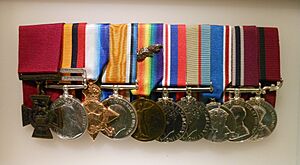James Newland facts for kids
Quick facts for kids
James Newland
|
|
|---|---|

Captain James Newland c.1918
|
|
| Born | 22 August 1881 Highton, Victoria |
| Died | 19 March 1949 (aged 67) Caulfield, Victoria |
| Allegiance | Australia |
| Service/ |
Australian Army |
| Years of service | 1899–1902 1903–1909 1910–1941 |
| Rank | Lieutenant Colonel |
| Unit | 12th Battalion (1914–18) |
| Battles/wars | Second Boer War First World War
|
| Awards | Victoria Cross Meritorious Service Medal Mentioned in Despatches |
James Ernest Newland (born 22 August 1881 – died 19 March 1949) was an Australian soldier and police officer. He is famous for receiving the Victoria Cross, which is the highest award for bravery in the face of the enemy for soldiers from Britain and the Commonwealth. Newland earned this medal for his amazing courage during three different battles in April 1917. At that time, he was leading his company against German forces who were pulling back to a strong defensive line called the Hindenburg Line. He successfully led his men in several attacks and fought off many enemy counter-attacks.
Born in Highton, Victoria, Australia, James Newland joined the Australian military in 1899. He fought in the Second Boer War in South Africa. After returning home, he continued to serve in the Australian Army and later became a police officer in Tasmania. When World War I began, he joined the Australian Imperial Force. He was one of the first soldiers to land at Gallipoli. He was wounded there and later became an officer.
In 1916, Newland moved to the Western Front in France. He was recognized for his strong leadership during a battle at Mouquet Farm. He was wounded two more times during the war. After the war, he continued to serve in the army and retired as a lieutenant colonel in 1941. He passed away in 1949.
Contents
James Newland's Early Life
James Newland was born in Highton, Victoria, a suburb of Geelong, on 22 August 1881. In 1899, when he was 18, he joined the military as a private. He was sent to South Africa to fight in the Second Boer War.
After the war, in 1902, Newland returned to Australia. He joined the Royal Australian Artillery in 1903. He served in the artillery for over four years. In 1909, he became a police officer with the Tasmanian Police Force. However, he rejoined the permanent army in 1910. He married Florence May Mitchell in 1913.
Fighting in World War I
When World War I started in August 1914, Newland quickly joined the Australian Imperial Force. He was assigned to the 12th Battalion. He sailed from Australia to Egypt for training. The 12th Battalion trained in the Egyptian desert for four months.
Landing at Gallipoli
On 25 April 1915, the 12th Battalion was among the first Australian and New Zealand soldiers to land at Anzac Cove in Gallipoli. This was a very dangerous landing. Newland was wounded in the arm a few days later and had to be taken to a hospital. While recovering, he was promoted to second lieutenant. He returned to his battalion soon after.
Newland fought in Gallipoli until June 1915. He was then put in charge of the battalion's transport in Egypt. In October, he was promoted to lieutenant. After the Allied forces left Gallipoli in December, Newland's battalion returned to Egypt. He was promoted to captain in March 1916 and became the adjutant (a senior administrative officer) of the 12th Battalion. Later that month, they sailed to France to fight on the Western Front.
Battles on the Western Front
In France, the 12th Battalion first fought in minor battles. In July, they moved to the Somme region and took part in the Battle of Pozières, their first major battle in France. Newland was put in command of A Company. His company then prepared for an attack on Mouquet Farm.
Mouquet Farm was a ruined area connected to strong German defenses. On 21 August, Newland led his company in an attack on trenches near the farm. His company captured their targets. Newland quickly organized his men into a defensive position, showing great calmness and bravery under heavy fire. For his actions, he was recommended for an award. He later received a Mentioned in Despatches, which means his bravery was officially recognized.
After these battles, Newland was briefly in Belgium before returning to the Somme. He was sick for a short time but returned to his battalion. In February 1917, Newland led his company in an attack on the village of La Barque. During this fight, he was shot in the face. He recovered and returned to his unit in March.
Earning the Victoria Cross
In April 1917, the Australian forces planned to capture three German-held villages. James Newland was awarded the Victoria Cross for his incredible bravery during three separate actions in these attacks.
Capturing Boursies Village
On the night of 7/8 April, Newland's 12th Battalion was tasked with capturing the village of Boursies. Newland led his company towards the village. They faced heavy machine gun fire from a ruined mill. Many soldiers were wounded. Newland bravely rallied his men and charged the mill, throwing grenades at the Germans. This attack forced the Germans out, and his company secured the area.
On 8 April, the Germans launched a strong counter-attack on Newland's position at the mill. They managed to enter some of the forward posts. Newland quickly brought up more soldiers and, with the help of Sergeant John Whittle, charged the attackers. They successfully pushed the Germans back and regained the lost ground.
Defending Lagnicourt
After a short break, the 12th Battalion was at Lagnicourt on 14 April. The next day, the Germans launched a fierce counter-attack. They broke through the Australian lines and surrounded Newland's company. Newland skillfully pulled his company back to a sunken road and set up a strong defensive position.
The German forces attacked Newland's company many times, but he and his men fought them off each time. During one attack, Newland saw that the Germans were weakening. He gathered twenty men and led a charge, capturing forty German soldiers as prisoners. With reinforcements, a combined counter-attack was launched, and the original line was recaptured.
For their amazing bravery at Boursies and Lagnicourt, both Newland and Sergeant Whittle were awarded the Victoria Cross. They were the only two permanent members of the Australian military to receive this award during World War I. Newland was 35 years old, making him the oldest Australian to receive the Victoria Cross in that war.
The official statement about Newland's Victoria Cross said he showed "most conspicuous bravery and devotion to duty, in the face of heavy odds, on three separate occasions." It praised his leadership in organizing attacks, rallying his company, and driving off enemy counter-attacks even when his company was attacked from behind. It noted that his "tenacity and disregard for his own safety" encouraged his men to hold out, and his stand had "far-reaching results."
Later War Service
In May 1917, Newland was wounded for the third time during a battle at Bullecourt. He was shot in his left armpit. He was sent to a hospital in England to recover.
After recovering, Newland attended a special ceremony at Buckingham Palace on 21 July. There, King George V personally presented him with his Victoria Cross medal. Newland then returned to Australia in September and was medically discharged from the army in March 1918.
James Newland's Later Life
After the war, James Newland continued to serve in the permanent military forces as a captain. He held several important roles in the army between the two world wars. His first wife, Florence, passed away in 1924. In 1925, he married Heather Vivienne Broughton, and they later had a daughter.

Newland was promoted to major in 1930 and received the Meritorious Service Medal in 1935. When World War II began, he took on new duties at Army Headquarters in Melbourne. He retired from the army in August 1941 with the honorary rank of lieutenant colonel.
After retiring from the army, Newland worked for the Australian Red Cross Society and later at an Ammunition Factory. He passed away suddenly from heart failure at his home in Caulfield, Victoria, on 19 March 1949, at the age of 67. He received a full military funeral and was buried at Brighton Cemetery. In 1984, his daughter, Dawn, donated his medals to the Australian War Memorial in Canberra, where they are now displayed.




